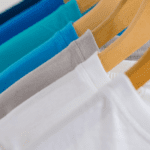As sustainability becomes increasingly essential in our everyday choices, the European Union is revising its textile labelling regulation. The move aims to tackle the environmental impact of textile production and consumption, which significantly affects our planet. Here’s an in-depth look at the changes, their implications, and what they mean for consumers and businesses alike.
The EU strategy for sustainable and circular textiles
The planned revision of the textile labelling regulation is just one initiative of the EU’s wider strategy for sustainable and circular textiles. This was published under the EU Green Deal, and it highlights a crucial issue: the environmental footprint of textiles. The average European household’s textile consumption is the fourth largest contributor to environmental degradation and climate change, ranking just behind food, housing, and transport. Additionally, textiles are the third highest in water and land use globally, just after food and recreation.
The strategy also addresses the economic challenges that the textile sector faces, such as post-COVID-19 recovery and geopolitical tensions that have disrupted supply chains. The industry’s recovery and competitiveness are vital, and the EU’s legislative efforts aim to support this.
The revision of the textile labelling regulation
Under the revised Textile Labelling Regulation, the European Commission plans to establish a single, uniform set of rules for labelling requirements, covering textile products, leather, fur apparel, clothing accessories, and household products. Notably, footwear is excluded as it is governed by Directive 94/11/EC (the labelling of materials used in footwear).
This revision will align with other proposed legislations like the Ecodesign for Sustainable Products Regulation (ESPR) and its Digital Product Passport, the Waste Framework Directive amendment regarding textile waste, and the Directive on Empowering Consumers for the Green Transition. Synergies with regulations like the General Product Safety Regulation and the Organic Production Regulation will also be explored.
Why the revision is necessary
The EC undertook a partial evaluation of the Textile Labelling Regulation almost a decade ago. Since then, significant regulatory, technological, market and environmental changes have emerged. Evaluating and potentially amending the regulation is crucial to address new challenges effectively.
Therefore, the EC’s new evaluation will assess the regulation’s relevance, effectiveness, consistency, efficiency, and added value. It will consider single market integration, competitiveness (especially for SMEs), consumer protection, and environmental protection. This comprehensive assessment will ensure that the regulation aligns with current EU legislation and market needs.
Identified issues
Three primary issues have been identified in relation to current textile labelling
- Fragmentation of the single market: Disparate rules across Member States lead to increased compliance costs and confusion for businesses and consumers
- Lack of consumer information: Consumers need clear, consistent information to make informed decisions about the products they buy and how to use them responsibly
- Environmental sustainability: The uncoordinated approach to environmental information on textile products exacerbates sustainability challenges
Most textiles consumed in Europe are produced in third countries. In 2022 alone, the EU imported €98 billion worth of clothing. The environmental impact of these textiles is significant, making harmonised labelling crucial for sustainable consumption.
Objectives of the revision
The revision aims to
- Reduce compliance costs for companies by streamlining national legislation
- Ensure consumers have accurate, intelligible, and comparable information about textile products, including their environmental impact
If the current regulation remains unchanged, misalignment with Member States’ legislation and industry practices will increase. This will lead to confusion and inefficiencies, despite other regulatory efforts like the ESPR Delegated Act for Textiles.
Potential impacts of the revision
The revision will have several anticipated impacts
- Economic impacts
- Simplification of legislation: Harmonising rules will reduce the burden on companies and streamline industry practices, promoting economic efficiency
- Digital labelling: Incorporating digital product passports and other technological solutions will modernise labelling practices, aligning with the broader digital economy
- Social impacts
- Competitiveness: The revised regulation is expected to enhance the competitiveness of the EU textile sector, potentially leading to job creation
- Social responsibility: Labelling on socially responsible production will promote ethical business practices and benefit workers and suppliers
- Environmental impacts
- Sustainability labelling: Providing clear, accessible information on sustainability will encourage greener consumer practices and better waste management
- Uniformity in labelling: Harmonised labels for origin, size, care, and other aspects will support the second-hand market, reduce transportation carbon footprints, and enhance product durability
State of play
The European Commission is recently closed a portal in which stakeholders are able to provide comments on the Impact Assessment. They will now be reviewing the comments made by the various stakeholders, which includes businesses, consumers, environmental and social organisations, and public authorities. The aim is to gather evidence on the regulation’s current functioning, identify problems, and seek opinions on potential solutions.
The new regulatory text is expected to be published in the first quarter of 2025.
Conclusion
The revision of the EU Textile Labelling Regulation is a significant step towards a more sustainable and competitive textile industry. By addressing the fragmentation of the single market, enhancing consumer information, and promoting environmental sustainability, the EU is paving the way for a greener and more efficient future.
How we can help
For information on the services Eurofins can offer within the textile industry, explore our Sustainable Textiles page. Alternatively, you can contact our sustainability services team for more information.



